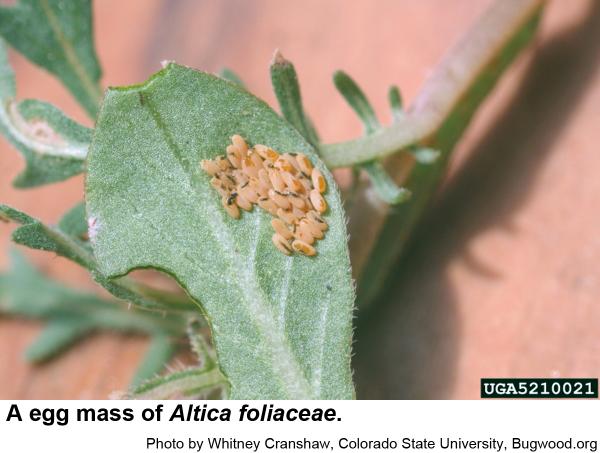Description and Biology
The crapemyrtle flea beetle, Altica litigata, is also called the water primrose flea beetle, the evening primrose flea beetle, and the primrose willow flea beetle. This is a small, dark, metallic, blue-green leaf beetle is called a flea beetle because it can jump more or less like a flea. Both adult beetles and their grubs feed on the leaves of plants in the primrose family. This is different from many other leaf beetles whose grubs feed only on the roots of various plants. Although the adults can be a significant pest of crape myrtle, crapemyrtle flea beetle grubs are never found feeding on crape myrtle. Crapemyrtle flea beetles chew irregularly shaped, somewhat circular holes in the leaves of crape myrtle as well as in the leaves of Ludwigia (water primrose), and other related plants in the Primulaceae. Small, yellowish, oblong eggs are laid in loosely organized groups on the leaf surface. Small grubs hatch and feed in small groups that skeletonize the leaves. Grubs have black heads but otherwise are greenish yellow with black spots on their bodies. After grubs mature, they crawl down and burrow into the soil to pupate. Grubs form a loosely constructed chamber usually located just below the soil surface in which they molt into a naked, yellow pupae. New adult beetles emerge some time later.
Host Plants
Crapemyrtle flea beetles do indeed feed on crapemyrtle (Lagerstroemia), but only adults have been collected there. They have a distinct preference for L. indica rather than L. fauriei cultivars. These beetles have been found on evening primrose and other plants although the normal hosts for this flea beetle are plants in the genus Ludwigia (water primrose, rattlebox, or water purslane). It has also been reported from purple loosestrife, Lythrum salicaria.
Residential Recommendations
Most of the insecticides labeled for use in residential landscapes should give more than adequate control on crape myrtle. However, because water primrose is semiaquatic, it is not a good idea to use pyrethroid insecticides near standing water (pyrethroids are toxic to fish and other aquatice animals).
Other Resources
- Differential Resistance Among Crape Myrtle (Lagerstroemia) Species, Hybrids, and Cultivars to Foliar Feeding by Adult Flea Beetles (Altica litigata). Cabrera, R. I. et al. HortScience 43 (2):403-407.
- Host Plants of Leaf Beetle Species Occurring in the United State and Canada. Clark, S. M. et al.2004. Coleopterist's Society Special Publ no. 2. 476 pp.
- Insects and Other Arthropods That Feed on Aquatic and Wetland Plants. Center, T. D. et al. 2002. USDA ARS Technical Bull 4870.
- Water Primrose. Bayne, D. et al. No Date. AquaPlant, A Diagnostics Tool for Pond Plants and Algae. Texas A&M AGriLife Extension.
- Extension Plant Pathology Publications and Factsheets
- Horticultural Science Publications
- North Carolina Agricultural Chemicals Manual
For assistance with a specific problem, contact your local Cooperative Extension Center.
This Factsheet has not been peer reviewed.
Publication date: March 14, 2019
Reviewed/Revised: Dec. 20, 2023
Recommendations for the use of agricultural chemicals are included in this publication as a convenience to the reader. The use of brand names and any mention or listing of commercial products or services in this publication does not imply endorsement by NC State University or N.C. A&T State University nor discrimination against similar products or services not mentioned. Individuals who use agricultural chemicals are responsible for ensuring that the intended use complies with current regulations and conforms to the product label. Be sure to obtain current information about usage regulations and examine a current product label before applying any chemical. For assistance, contact your local N.C. Cooperative Extension county center.
N.C. Cooperative Extension prohibits discrimination and harassment regardless of age, color, disability, family and marital status, gender identity, national origin, political beliefs, race, religion, sex (including pregnancy), sexual orientation and veteran status.





